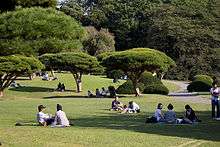Shinjuku Gyoen


Shinjuku Gyoen National Garden (新宿御苑 Shinjuku Gyoen) is a large park with an eminent garden in Shinjuku and Shibuya, Tokyo, Japan. About 31% of the park's area is in Shibuya Ward, with the remaining 69% in Shinjuku Ward. It was originally a residence of the Naitō family in the Edo period. Afterwards, it became a garden under the management of the Imperial Household Agency of Japan. It is now a park under the jurisdiction of the national Ministry of the Environment.
History
The shogun bequeathed this land to Lord Naitō (daimyo) of Tsuruga in the Edo period who completed a garden here in 1772.[1] After the Meiji Restoration the house and its grounds were converted into an experimental agricultural centre.[2] It then became a botanical garden before becoming an imperial garden in 1879. The current configuration of the garden was completed in 1906. Most of the garden was destroyed by air raids in 1945, during the later stages of World War II. The garden was rebuilt after the war.
The jurisdiction over the Imperial Palace Outer Garden and the Kyoto imperial garden was transferred to the Ministry of Health and Welfare (now part of the Ministry of Health, Labour and Welfare) in 1947.
On May 21, 1949 the garden became open to the public as "National Park Shinjuku Imperial Gardens". It came under the jurisdiction of the Ministry of the Environment in January 2001 with the official name "Shinjuku Gyoen National Garden".
In 1989, the Shinjuku Gyoen was the site chosen for the funeral rites of Emperor Shōwa before he was buried at the Musashi Imperial Graveyard.
Features
The garden, which is 58.3 hectares in area with a circumference of 3.5 km, blends three distinct styles: a French Formal and English Landscape in the north and to the south a Japanese traditional. A traditional Japanese tea house can be found within the gardens.
The garden is a favourite hanami (cherry-blossom viewing) spot, and large crowds can be present during cherry blossom season.
Flora
The garden has more than 20,000 trees, including approximately 1,500 cherry trees which bloom from late March (Shidare or Weeping Cherry), to early April (Somei or Tokyo Cherry), and on to late April (Kanzan Cherry). Other trees found here include the majestic Himalayan cedars, which soar above the rest of the trees in the park, tulip trees, cypresses, and plane trees, which were first planted in Japan in the Imperial Gardens.
Horticulture work has been going on in the greenhouses in the garden since 1892. The present greenhouse, built in the 1950s has a stock of over 1,700 tropical and subtropical plant species on permanent display.
Entrances and Admission
The garden has three access gates: Shinjuku Gate, Okido Gate and Sendagaya Gate. Shinjuku Gyoen is open from 9:00 until 16:30. On Mondays the garden is closed, except during the cherry blossom and chrysanthemum seasons: late March–late April and early November respectively, when the garden is open seven days a week. The greenhouse, is open from 9:30 until 16:00. The last admission is 16:00.
Admission is JPY 200 for adults, JPY 50 for children.
Location
The garden is a short walk from Shinjuku-gyoemmae Station on the Marunouchi Line or Sendagaya Station on the Chūō-Sōbu Line.
The garden is on the Fukutoshin Line near Shinjuku-sanchōme Station. From that station (exit C1) the garden is a four-minute walk.
Shinjuku Gyoen should not be confused with Shinjuku Central Park, which is located behind the Tokyo Metropolitan Government Building in Nishi-Shinjuku.
References
Bibliography
- Mansfield, Stephen (2011). Japan's Master Gardens - Lessons in Space and Environment (Hardback). Tokyo, Rutland, Singapore: Tuttle. ISBN 978-4-8053-1128-8.
External links
| Wikimedia Commons has media related to Shinjuku Gyoen National Garden. |
Coordinates: 35°41′07″N 139°42′31″E / 35.68533°N 139.70850°E